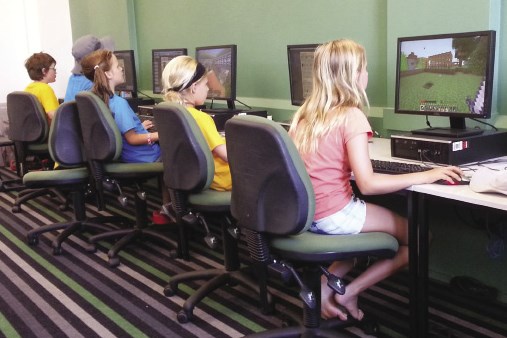Issue 95
Term 4 2015
Engaging girls in STEM
Pru Mitchell discusses the importance of promoting an interest and enjoyment in STEM (Science, Technology, Engineering and Mathematics) among female students. Pru proposes seven steps that school libraries can take to further engage girls in STEM.
It seems recently that everywhere we turn we read about girls and science, girls and technology, and girls' career choices. It is a popular theme in the media, which extends also to social media. A search of Twitter on the hashtag #stem reveals a high proportion of photos and links that relate to girls and women. From the Chief Scientist to executives in the gaming industry the message is 'where are the girls in STEM?' Increasingly this concern is broadening to encompass all students, as overall engagement in science, mathematics and technology falls.
In August, as we celebrated National Science Week and Children's Book Week, we were prompted to consider what role the school library could have in igniting interest in science and technology, particularly amongst girls. While the Book Week theme 'Books light up our world' linked neatly to this year's International Year of Light, can libraries build on this, and develop services that support school, system and national STEM priorities?

Students at an Invent the World school holiday program.
What is STEM?
STEM is used as an umbrella term to refer to Science, Technology, Engineering, and Mathematics. It became a trend early in the 21st century and provides a convenient hook to hold together the non-arts and humanities disciplines. The Science and Mathematics parts of STEM need little explanation. Technology in STEM encompasses both the Technologies learning area and Information and Communication Technology (ICT) capability. While there is no subject called Engineering in most school curriculum frameworks, its central pillars of problem solving, research, planning, designing, and building are readily recognised through other learning areas. A search of the Australian Curriculum for 'engineering' returns relevant results in Technologies (24), Science (17), and Mathematics (1).
There is a wealth of literature and resources available about STEM education. One key point is that for most writers STEM is about integration of these four disciplines in an interdisciplinary approach. There is also a movement that advocates the inclusion of Arts in the mix, preferring the idea of 'STEAM'. Whatever the line, this theme has ignited an enormous range of initiatives, funded by governments, commercial giants, philanthropics and grassroots organisations, all looking to solve a perceived problem.
Where is the research?
Given the amount of material published about STEM education, and the frequent references to the under-representation of girls and women across a range of endeavours, it is surprising how little in-depth research there has been in Australia in recent years. Library staff at ACER recently reviewed research in the Australian education literature from 2011 onwards to find research into ICT and gender, looking to identify any policies, practices, and programmes in Australia that focus on ICT, education, women, and/or girls. While this search was specifically about ICT in education, it is a useful place to start as the literature on STEM in Australian education is more limited. Two Australian reports are reviewed here.
ICT Skills and Training Development: a state of play paper by the Australian Information Industry Association (2012) addresses issues at different levels of education related to lack of females in the industry. The statistics it presents make for disheartening reading (p.8). The report suggests that there may be 'a branding problem', related to how ICT is packaged within education and training (p.7).
The Digital Divas project was a 2009-2011 ARC Linkage project conducted in schools by researchers from Monash, Swinburne, and Deakin Universities. The final project report (2012) suggested multiple contributing factors to the low participation by females in ICT. At the individual level many girls lacked confidence, knowledge of careers, game playing experience, and parental advice. In their educational institutions it was often regarded as atypical for girls to be interested in these subjects, and both the curriculum and teachers were identified as potential factors. The public image of the ICT profession was an issue, seen as having an alienating culture, involving constant change and being somewhat unstable as a career option (p.6). Digital Divas course materials are available for re-use by schools.
What does testing tell us?
In the 2015 paper Australian students in a digital world, Dr Sue Thomson summarises the findings related to gender from several large scale assessment programs. She concludes that, 'despite their obvious aptitude, female students in Australia reported significantly lower levels of interest and enjoyment in using computers than male students' (p.15).
Where to from here?
There is research that confirms the state of affairs concerning girls and technology in particular, and STEM in general. There have been many billions invested in programs looking to change the situation. The real challenge is to go beyond studies of what is happening, to determine why girls are opting out. This appears to be one of those 'wicked problems' for which there is no quick fix. If a solution existed, surely one of these studies or programmes would have found it.
However, this conclusion is no excuse for giving up on the goal of better representation of girls in STEM endeavours. Campbell (1996) writing about engineering education in the tertiary sector concludes 'that failure to solve the attrition problem stems partially from an overemphasis on the student deficit model and under emphasis on institutional deficiencies.' So rather than looking at girls as the problem, let's look at what we are offering girls in terms of STEM.
Seven STEM steps for school libraries
After reading this research, we suggest a number of areas where school libraries might contribute to their school's STEM programmes.
1. Prioritise STEM
Science, Mathematics, and Technologies are significant learning areas in most current curriculum frameworks. However, they probably do not attract equal time and attention in library programmes throughout a child's schooling compared to Arts, Language, Literacy, Humanities and Social Sciences. The Chief Scientist is understandably forthright in what is required, including 'a core STEM education for all students – encompassing inspirational teaching, inquiry-based learning and critical thinking – placing science literacy alongside numeracy and language proficiency as a priority' (Chubb, 2014, p.23).
2. Prepare for Technologies curriculum
Through their expertise in information literacy, school libraries have been closely connected to the ICT general capability. Now the Australian Curriculum: Technologies is available, and implementation is imminent – or underway in some places – it represents an opportunity for school libraries. Teacher librarians can work with technology specialists, skilling up in this area, and preparing to support the teaching of the Digital Technologies and Design and Technology subjects.
3. Source STEM resources
An obvious role for the library is to ensure access to resources that support STEM curriculum and extension initiatives. Subscriptions to quality publications for students and teacher reference are essential in this fast moving area. Genres such as science fiction and steampunk are a starting point, and checking the SCIS Catalogue for STEM-related subject headings with a fiction subdivision can provide ideas for building the collection.
Visual resources are useful for engineering-related topics, including photographs, plans, and video of objects in natural and built environments. Accommodating learning activities and assessment that go beyond text production will involve researching software that is accessible for students to use for brainstorming, designing, drawing, and developing flowcharts.
4. Build partnerships
STEM is an area where local industry partnerships can be invaluable, providing opportunities for mentoring, work experience, parent education and community support programs. Role models and mentoring are acknowledged as success factors in the research, addressing issues such as self-confidence and knowledge about careers. One strategy is a living library program where students can interview women who are successful in roles involving science, technology, engineering and mathematics, and are comfortable sharing their own story.
5. Promote STEM careers
While STEM education is about more than girls choosing careers in this area, it is nevertheless a highly visible measure of success, and is a goal of many programs. Myfuture lists 269 results for ICT related careers and over 1,500 results related to computers or computing. Using the Bullseye poster for computing is an easy first step in starting discussion on the range of options that STEM opens up.
Career resources are one strategy, but research shows that post Year 9 is too late to start changing girls' perceptions. Openness to STEM careers for girls needs attention much younger than traditional career education units. This is an excellent opportunity for primary libraries. The library can host after school or school holiday STEM or coding programs with male and female tutors, such as the one run by Victorian-based organisation Invent the World. This allows girls to have female role models actively working in STEM.
6. Make space for STEM
Maker spaces are one increasingly popular response to involving children of all ages in planning, designing and building. In an increasingly virtual world, the hands-on, tactile experience has become a novelty and thus a powerful tool for engagement. There is a need for caution however; as with ICT initiatives, it is the learning and curriculum that must drive these programs, not the novelty or convenience of a particular commercial package.
There are inexpensive initiatives in which school libraries can encourage student involvement, such as the Australian STEM Video Game Challenge which invites students to create an original video game based on STEM themes and concepts as a strategy for growing the interest and participation. This is based on research from both education and neuroscience that video games enhance a range of cognitive functions and generate responses in the brain associated with attention and learning. Resources such as Scratch and Code make it possible to establish a school-based coding club.
7. Read and research STEM
In a field such as STEM it is essential to be reading, debating and updating our knowledge and resources. The free online publication Teacher has independent, evidence-based articles that are practical and easy to read. STEM is one of their regular themes. A school subscription to the Digital Education Research Network (DERN) will give all teachers access to a weekly newsletters and research reviews. Check out the full list of reviews on Girls in ICT.
Finally, if you undertake a successful STEM activity or some action research into STEM and technology at your school, please consider publishing your findings in Connections or Teacher so others can build on your work.
References
- Australian Information Industry Association (AIIA). (2012). ICT Skills and Training Development: A 'State of Play' Paper. https://c.ymcdn.com/sites/www.aiia.com.au/resource/collection/6CB90865-34C6-4B81-9805-69AE4FD335CD/State_of_Play_Skills_Paper_Final_231112.pdf.
- Campbell, G. (1996). 'Bridging the ethnic and gender gaps in Engineering'. NACME Research Letter, 6(1). ED401108.
- Chubb, I. (2014). Science, Technology, Engineering and Mathematics: Australia's Future. Office of the Chief Scientist, Canberra. http://www.chiefscientist.gov.au/wp-content/uploads/STEM_AustraliasFuture_Sept2014_Web.pdf.
- Digital Divas: Designing approaches to enthuse girls' interest in ICT studies and ICT careers (2012). http://digitaldivasclub.org/vic/node/35.
- Thomson, S. (2015). Australian students in a digital world, ACER, http://research.acer.edu.au/policyinsights/3.
Image credits
- © Invent the World. Used with permission.
